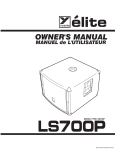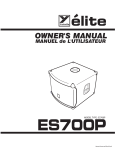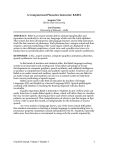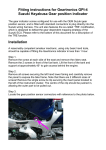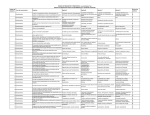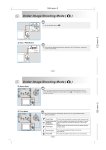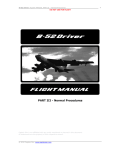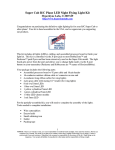Download Black Box ME262C Operating instructions
Transcript
Me-262 A-1 Pilots Handbook Provided courtesy of Zeno’s Warbird Video Drive-In www.zenoswarbirdvideos.com c 2005 www.zenoswarbirdvideos.com Section 1 - DESCRIPTION GENERAL a. The Me-262 is a single-place, jet-propelled aircraft used as a fighter-bomber. The low swept-back wing is a symmetrical airfoil section with square tips. Automatic leading edge wing slots are incorporated in the wing design. The fuselage of of the Me-262 is triangle shaped with an unusually long nose, and a tail assembly of a single fin and rudder. The undercarriage is a squat tricycle type. Power is provided by two propulsion units under the wing. b. The approximate dimensions of the aircraft are as follows: (1) Wing span 41 ft. (2) Overall length 34 ft. 9 in. (3) Height of fin above the ground 11 ft. 4 in. c. The airplane gross weight runs between 10,154 lb. (empty) and 14,272 lb. (with maximum fuel). d. The propulsion units consist of two Junkers TL (Jumo 004) axialflow type jet engines. The power output is controlled by the rate at which fuel is supplied to the burners. FLIGHT CONTROLS a. The flight controls are conventional, using push-pull rods throughout. (1) The ailerons were designed to use servotabs, but the air craft received have had the aileron tabs converted to a ground adjustable type, using turnbuckles for adjustment. (2) The elevator trim tabs were also intended to be of the servotype, but, on the aircraft received, have been fixed by riveting in position. (3) The rudder employs a controllable tab, operative from the cockpit. The tab control is on the left side of the cockpit. (See fig. 2-11). A position indicator (See fig. 2-12) indicates the amount of tab adjustment. b. There is a horizontal stabilizer trim control and indicator. The angle of incidence of the stabilizer is varied by an electric motor to trim the aircraft. Control is operated by lever. (See fig. 2-3.) Horizontal stabilizer position is shown on indicator (See fig. 2-4.) Power is supplied to the controls by the switch in the main switch panel. (See fig. 4-9.) c. Wing flaps. (1) The Handley-Page type flaps are operated by two push buttons. (See fig. 3-2). Flap position is indicated by graduations of 0°, 10% 20°, 30°, 40% and 50° marked on the upper surface of the flap; the 20° position used for take-off is marked in red. (2) Emergency lowering of the wing flaps is accomplished by the use of an emergency compressed air system. Operation is accomplished by opening the operating handle (See fig. 2-2), two complete turns. Warning: Be sure the valve is opened two complete turns. THROTTLE CONTROLS a. The throttle controls are located at the pilot's left, (See fig. 2-9) and are the only power controls on the airplane. The black buttons, one on each throttle, are used to close the circuits for starting ignition on the engines. The throttles are equipped with stops to prevent accidental full closing and stalling of the engines. LANDING GEAR CONTROLS a. Under normal conditions the landing gear is raised or lowered by use of the two push buttons. (See fig. 3-3). It is hydraulically operated, but because of the low capacity of the hydraulic pump, it is slow in operation. b. Compressed air is used for emergency operation of the under carriage, but lowers the nose wheel and main undercarriage fair ing only. The undercarriage itself falls under the influence of gravity, and locking may require the assistance of slide slipping. Operation of the compressed air emergency system is accomplished by opening the operating handle (See fig. 2-1) at least two complete turns. Warning: Be sure to open two complete turns. c. Landing gear position indicators are provided for each unit of the undercarriage indicator, (See fig. 3-5) left main gear indicator, (See fig. 3-6) nose wheel, and indicator, (See fig. 3-7) right main gear. BRAKE CONTROLS a. The brakes embody a conventional hydraulic system, independent of the landing gear and flap hydraulic system. Operation is accomplished by applying pressure with the toes on the rudder pedals. b. A brake is also incorporated in the nose wheel. Operation is accomplished by use of the nose wheel brake control lever, (See fig. 1-17). www.zenoswarbirdvideos.com HYDRAULIC SYSTEM CONTROLS a. The engine driven hydraulic pump is in operation whenever the port engine, to which it is attached, is operating. Because of the low capacity of the pump, operation of the landing gear is slow, and time allowance must be considered when approaching for a landing. b. Hydraulic power is used to operate the flaps and landing gear. c. A compressed air emergency system is incorporated to be used for lowering flaps and landing gear in event of failure of the hydraulic system. ELECTRICAL CONTROLS a. The electrical system is in operation whenever the battery switch, (See fig. 4-13) and the generator switches, (See fig. 4-11 and 12) are in the "on position. b. A circuit breaker is located to the left side of the cockpit, (See fig. 3-1) and relieves the entire electrical system in the event of an overload. The circuit breaker can be reset by pushing the button (See fig. 3-1). c. The external power supply plugs into a socket on the right hand side of the fuselage just above the wing. d. The inverter switch is located in the main switch panel. fig. 4-10). (See FUEL SYSTEM CONTROLS a. The capacities of the four (4) fuel tanks are as listed: 1. Front main fuel tank 240 gal. 2. Rear main fuel tank 204 gal. 3. Front auxiliary tank 53 gal. 4. Rear auxiliary tank 158 gal. 655 gal. Total b. Fuel is supplied to the engines from the two main fuel tanks, one located in front of the pilot and one in back of the pilot. Either engine can be supplied from either tank, depending upon the position of the fuel selector and shut off controls located next to the throttles. (See fig. 2-10). The fuel pumps are put into operation by the push button switches located in the main switch panel. (See fig. 4-3 and 4.) c. Fuel transfer is accomplished by operation of the push button switch located in the main switch panel. (See fig. 4-2). Fuel is transferred from the rear auxiliary tank to the main fuel tanks only. Transfer from the auxiliary fuel tank located beneath the pilots' compartment is accomplished by pumping into the rear auxiliary tank and then into the main fuel tanks, Fuel transfer is automatic upon operation of the fuel transfer switch. Fuel is transferred at unequal rates into the forward fue1 tank. PILOT HEAT CONTROLS a. Pilot heat is applied by operating the pilot heat switch located in the main switch panel. (See fig. 4-8). WINDSHIELD DEFROSTING a. Windshield defrosting is accomplished by applying windshield heat through operation of the windshield heater switch. (SEE fig. 4-23). NAVIGATION LIGHTS a. The lights are operated by a switch located in the main switch panel. (See fig. 4-7). www.zenoswarbirdvideos.com Section 2 - PILOT OPERATING INSTRUCTIONS BEFORE ENTERING PILOT"S COMPARTMENT a. Flight Restrictions: Only normal flying maneuvers should be performed with this airplane until further data is obtained. No high-speed dives should be run. b. Air-Speed Limitations: The maximum allowable airspeed (IAS) is 950 km/hr (590 mph.) c. Center of Gravity Position: With the three forward fuel tanks full and the rear one empty, the best center of gravity position will be maintained. This is 156 in. aft of the nose. d. Take-off Gross Weight and Balance: (1) The normal take-off gross weight is 14,272 lb, 10,154 1b. basic, plus 4118 lb. for fuel, pilot, and ballast. (2) The most rearward permissible position of the center of gravity is 30% MAC. If this position is exceeded, the airplane becomes unstable about the lateral axis, is apt to yaw about the vertical axis, and automatically stalls in a turn. Under normal conditions of fuel capacity this position is not exceed ed. Refer to fuel through directions. e. How to Gain Entrance: The cowling on the left hand engine incorporates two steps and a hand-hold which permit easy access to the top of the wing. Another step is provided in the fuselage below the cockpit canopy for entry into the cockpit. The central portion of the canopy is hinged along the right hand edge and is raised from the left hand side. It can be locked in place only from the inside. ON ENTERING PILOT'S COMPARTMENT a. Check before all flights: (1) Check weight and balance. (2) Check Form 1. (3) Diluter lever on "normal oxygen." (4) Oxygen regulator altitude dial on "normal." (5) Oxygen pressure 400 to 450 lb. one sq. in. (6) Set the altimeter and clock. (7) Battery switch (See fig. 4-13) "off." (8) Generator switches (See fig. 4-11 and 12) "on". (9) Pitot heat switch (See fig. 4-8) "off." (10) b. External power source connected. Special Check for night flying: (1) Navigation lights (See fig. 4-7). FUEL SYSTEM MANAGEMENT a. Fuel Selector Switches: The fuel valve controls, (See fig. 2-10) have three positions; rear position fuel shut off; center position rear main fuel tank; and forward position front main fuel tank. In order to maintain a suitable center of gravity, the following selector valve positions have been found to be practical: (1) When starting the jet units and taxiing: selector valves at "rear main fuel tank." Both fuel (2) During take-off and in flight: Left hand unit at "front main fuel tank" and right hand unit at "rear main fuel tank." After about ten min of flying time, switch on the fuel transfer system off the fuel transfer system when the fuel gage shows 900 liters (235 gal) as there may be danger of fuel running over, b. Fuel side Fuel (600 fuel into Transfer: Fuel transfer switches are located in the right of the cockpit, main switch panel. (See fig. 5-1). is pumped from the 53 gal (200 liter) tank to the 158 gal liter) tank and then to the front and rear main tanks. The is pumped into the rear main tank at a faster rate than the front main tank. The ratio is 3:1. STARTING PROCEDURES Warning: All personnel should keep a minimum distance of seven ~ " (7) feet from the intake and exhaust openings of the engines. a. (1) Connect external battery. (2) Turn on: (a) Battery switch (b) Inverter (c) Generators www.zenoswarbirdvideos.com Note: b. Electric fuel pumps are provided and can be used in cold weather conditions when unit is hard to start. These pumps supply gasoline to the burners. They should be shut off when a speed of 3000 rpm is reached. (3) Turn fuel selector valve "off". (4) Throttles closed. (5) Push down starter handle to prime Riedel starting motor. (6) Pull starter handle and hold; at the same time press tachometer button and hold. This puts tachometer in low speed range. (7) When jet unit has reached 700 to 800 rpm, press ignition button on right side of throttle and hold. A deep throbbing noise is heard as the unit begins firing. The speed will increase to 1800 to 2000 rpm at this time. (8) Release starter handle and tachometer button, open fuel selector valve (rear tank position) and slowly advance throttle to 3000 rpm. (9) At 3000 rpm release throttle ignition button. The jet unit is now running on the main fuel supply. temperature must not rise above 650°C. Exhaust If the jet unit fails to start, release throttle-ignition button. The tail pipe should be wiped clean of any injected fuel before repeating starting process. Otherwise a fire may start. Whenever there is fire or smoke in the turbines, release starter handle at once. Due to this fire hazard, a fire extinguisher should always be ready. WARM-UP AND GROUND TEST (1) Trim stabilizer at 0° tp +1°. tank use +2° to +3°. With full auxiliary (2) Set left engine fuel selector valve on "front tank and right engine fuel selector valve on "rear tank". (3) Set flaps at 20°. of flaps. (4) Open throttles very slowly to 7000 or 8000 rpm. At this speed the needle valve in the tail pipe should move to the fully extended rearward position. This is visible from the cockpit and indicates that maximum thrust is being developed. (5) Check exhaust temperature gage for not over 650°C. (6) Check fuel pump pressure gages for 50 to 80 kg/cm2. Graduations are marked on upper surface TAXIING a. Caution must be used in taxiing because the rudder is ineffective and steering by engine thrust is difficult as thrust builds up too slowly. Brakes are the only means of control, and taxiing should be done with jet units running at 4000 to 6000 rpm. The tail of the ship must not be turned toward inflammable objects. TAKE-OFF (1) Hold aircraft with main wheel brakes and open throttles very slowly to 7000 rpm. (2) Release brakes and open throttles fully. Make direction al corrections with brakes only. After flying speed (approximately 112 to 125mph (180 to 202 km/hr)) has been attained, pull gently back on stick to raise nose wheel and make the take-off. (3) Apply brakes and retract gear when airborne. Landing gear signal light should indicate wheels in "up" position. (4) Note: Retract flaps - airplane will not drop through. By opening throttles too fast up to 7000 rpm there is danger of causing cavitation in one of the compressor stages, that is, by running up too quickly the compressor is overloaded and the smooth air flow breaks up just as it does on a stalled wing. If take-off is continued, insufficient air flows through but the same amount of fuel is injected, resulting in insufficient power. ENGINE FAILURE DURING TAKE-OFF a. If the speed of the aircraft is low, close the throttles and apply the brakes. (Main wheel brakes are foot-operated, nose wheel brake is hand-operated). b. If already airborne, retract the landing gear as soon as possible, keep the nose down, and use the rudder as necessary to maintain direction until the rudder trim can be adjusted. Continue around the pattern, turning in the direction of the good engine. Minimum single engine speed is 260 km/hr (160 mph). CLIMB a. The best climbing speeds are given in the take-off and climb chart in Appendix 1. www.zenoswarbirdvideos.com GENERAL FLYING CHARACTERISTICS a. Stability: (1) This airplane has good aileron control at all altitudes and will do a good slow roll. (2) The airplane holds its speed in tight turns much longer than conventional types. (3) In climbing or turning, automatic slots in the leading edge of the wing open when the speed drops to 450 km/hr (280 mph). Slots open at 300 km/hr (185 mph) when the airplane is in a gliding angle. b. Trim Changes: The stabilizer trim control should not be used when going into or pulling out of a dive. The reason for this is that the entire stabilizer is moved up and down by an electric motor drive actuated by the trim control lever. Thus a slight deflection has a large effect, and it is easy to over-control, causing the ship to nose over or pull up more abruptly than intended. c. Changing Power in Flight: Move the throttles slowly forward or aft. STALLS a. Stalling characteristics are good, there being no bad tendencies to fall off into a spin. SPINS a. No spins are to be attempted with this airplane. PERMISSIBLE ACROBATICS a. No acrobatics are to be performed. DIVING a. There is reported to be no flutter while diving, possibly due to the high position of the horizontal stabilizer in relation to the wing. b. Speeds of 950 km/hr (590 mph) are reported to have been attained in a shallow dive 20° to 30° from the horizontal. No vertical dives were made. At speeds of 950 to 1000 km/hr (590 to 620 mph) the air flow around the aircraft reaches the speed of shound, and it is reported that the control surfaces no longer effect the direction of flight. The results vary with different airplanes; some wing over and dive while others dive gradually. It is also reported that once the speed of sound is exceeded, this condition disappears and normal control is restored. SPEED AND RANGE Flight Condition True Air Speed (Indicated) Max speed, 20° to 30° dive 950 km/hr (590 mph) Take-off with full fuel load (no bombs) Cruising speed 180 to 202 km/hr (112 to 127mph) Max speed, level flight 830 km/hr (515 mph) Landing approach 250 km/hr (155 mph) Stalling speed with full fuel load, landing gear and flaps down 202 km/hr (125 mph) 750 km/hr (465 mph) The flight duration of the aircraft varies from 45 to 90 min. Time of flight at low altitudes (below 10,000 to 12,000 ft.) is 45 to 50 min. At altitudes above 12,000 ft the time of flight is 60 to 90 min. The increased efficiency with altitude is a result of decreased air pressure. TO TURN OFF JET UNIT DURING FLIGHT a. Training or test flights: (1) Close throttle to idling position. (2) Turn off fuel pump, allowing rpm to decrease. (3) Fuel selector valve off. (4) Throttle closed. (5) Press ignition button throttle for five seconds. TO START DURING FLIGHT a. Do not start above 4 km (13,100 ft) because of fire hazard. www.zenoswarbirdvideos.com (1) Reduce airspeed to 300 km/hr (186mph). (2) Throttle closed. (3) Turn on fuel pump. (4) Press ignition button throttle until rpm increases by 1000. (5) Open fuel selector valve. (6) Advance throttle slowly to idling position. (7) Release ignition button when rpm is constant. (8) Adjust rpm to that of other unit. APPROACH AND LANDING a. Normal Landing: Do not lower landing gear above 4000 km/hr (248 mph). It may be expected that the nose will rise sharply as the landing gear starts down, but once the wheels are in landing position the aircraft will assume a normal attitude by retrimming stabilizer. The landing approach is made at 250 km/hr(155 mph). Use flaps as needed and carry 6000 to 7000 rpm so that throttles can be opened quickly in case of a go-around. Note: b. If rpm is less than 6000, any advance in throttles must be made slowly to 7000 rpm before opening wide. The airplane stalls at 180 to 202 km/hr (112 to 125 mph). In case of a very short flight in which the fuel has not all been used from the the auxiliary tanks, use caution in landing as the allowable landing weight is exceeded due to the fuel load. Take-off if landing is not completed: (1) If 6000 to 7000 rpm or over has been maintained on the approach, open throttles fully in going around. Note: If rpm has fallen below 6000 it is necessary to bring the units up to 6000 to 7000 rpm slowly, just as in take-off, before opening throttles. (2) Brake and retract landing gear. (3) Gradually raise flaps to take-off setting of 20°. STOPPING UNITS (1) Close throttles completely and press ignition buttons. (2) Shut off fuel selector valves. (3) Open fuel dump valve switches. In the event that power units should begin to burn, pull starter handles, re-ignite power plant and then repeat above shutting down process. BEFORE LEAVING THE PILOT'S COMPARTMENT a. Turn all switches off. www.zenoswarbirdvideos.com Section 3 - FLIGHT OPERATING DATA ENGINE OPERATING DATA Airplane Model Me-262 A-l Condition Exhaust Gas Temperature Fuel Pump Pressure Maximum 650°C. 80 kg/cm2 Maximum ---- 50 kg/cm2 Minimum Fuel Grade Jet engines: AN-F-32 Riedel starters: AN-F-23 (with % pt of engine oil added to each gallon). Oil Grade AAF Spec. No. 3606 Operating condition RPM Time Limit Take-off 8700 ± 200 5 min Military Max continuous (90%) “ “ 10 min 8400 AIR SPEED CORRECTION DATA (Information not available pending flight tests.) Section 4 - EMERGENCY OPERATING INSTRUCTIONS FLIGHT ON ONE JET UNIT a. The aircraft will fly at 450 to 500 km/hr (280 to 310 mph) on one jet unit. It operates best over 3 km (10,000 ft). b. The minimum single engine speed of 260 km/hr can only be reached by climbing too steeply or with landing gear down. c. Bank only in the direction of the good jet unit unless speeds over 260 km/hr (160 mph) are maintained. EMERGENCY SHUTDOWN OF JET UNIT DURING FLIGHT a. Jerk throttle closed. b. Turn fuel pump off. c. Turn fuel selector valve off. EMERGENCY OPERATION OF LANDING GEAR AND FLAPS a. Compressed air is used for emergency operation. It lowers the nose wheel and main landing gear fairing. The main gear falls and locks by the influence of gravity. If it does not immediately lock it can be helped by side-slipping. Both the landing gear and the flaps lower more quickly by the use of compressed air than hydraulically. The main gear goes down in 2 to 3 sec and the nose wheel goes down in 5 to 10 sec. Note: Two to three turns of the air valve are necessary to put compressed air into operation. TIRE BLOWOUT DURING TAKE-OFF OR LANDING a. Keep the airplane straight by using corresponding throttles and applying opposite brakes until the airplane comes to a stop. Bail-OUT a. Pull the emergency handle for cockpit canopy release. Bailout to one side. Wait approximately two seconds before pulling the ripcord. www.zenoswarbirdvideos.com LANDING WITH ONE JET UNIT a. Approach the field, turning in the direction of the good jet unit. b. Lower the landing gear by compressed air (two complete turns of air valve) when 3 to 4 km (2 to 2.5 miles) out on the land ing approach. Main gear goes down in 2 to 3 sec and the nose wheel goes down in 5 to 10 sec. c. Lower flaps as needed, as the airplane will not go around again on one jet unit. d. When the landing gear has been lowered by compressed air, the landing gear down button must be pressed when the jet units are running, before the next take-off. POSSIBLE FAILURES OF THE ENGINES IN STARTING AND IN FLIGHT a. In Starting (1) The Riedel Motor Does Not Start: The electro-motor in the Riedel is turning the jet unit over slowly. The voltage should read 20 v, in which case do not use the starter switch for more than 10 sec to avoid burning out the electro-motor. (2) The Riedel motor sounds as if it were running, but no rpm is indicated with the tachometer in the low-speed range. (a) Tachometer inoperative. (b) Starter claw is broken. (3) The ignition does not respond immediately; press the ignition button several times. If ignition finally takes place, long flames will come out of the jet unit. This will also happen if fuel has previously run into the jet unit. These flames will blow out. (4) The ignition is accidentally turned on when the jet unit is stopped, and flames come out of the unit. The ignition should be released and the Riedel motor started so that the air flow will extinguish the flames. If the Riedel motor is not used, a mechanic can either blow compressed air through the front or use a fire-extinguisher at the rear. b. In Flight. (1) Jet unit is extinguished: Indicated by: (a) Drop in rpm. Causes: (2) (b) Drop in fuel pressure. (c) Drop in gas pressure. (d) Drop in tail-pipe gas temperature and trailing of white smoke. (a) Throttle pulled back further than idling position. (b) Stoppage of fuel supply. (c) Insufficient injection pressure at high altitudes. Broken vanes in jet unit: Indicated by: Vibration of the unit. Action: Turn off the jet to prevent the fuel lines from breaking and causing a fire. (3) Damaged turbine starter vanes: Indicated by: (a) Fuel pressure increases rapidly. (b) Gas pressure increases rapidly. (c) Gas temperature increases rapidly. Action: Turn off the jet unit immediately to avoid fire. (4) Injection nozzle clogged: Indicated by: (a) Fuel pressure increases rapidly. (b) Gas temperature is abnormally high or low. Action: Turn off the jet unit immediately to avoid fire. (5) Loss of oil or oil pump inoperative: Indicated by: (a) RPM surges upward. (b) Gas temperature rises to the limit of gage. Action: Turn off the jet unit immediately to avoid fire. www.zenoswarbirdvideos.com (6) Thrust governor inoperative or the nozzle pin adjustment broken, in either case the thrust nozzle pin advances to the final notch: Indicated by: Action: (7) (a) Fuel pressure increases rapidly. (b) Gas pressure increases rapidly. (c) Gas temperature increases rapidly. Turn off the jet unit immediately avoid fire. Landing gear retraction trouble: (a) If the landing gear does not come up when the button is again pressed, reduce the speed to 160 mph and suddenly push down the nose. (b) If the signal lamp does not work, the retraction of the landing gear can be checked as follows: (1) If a slight rush of air is heard and the speed is 405 to 435 mph, the nose wheel is still down. (2) If a strong rush of air is heard and the speed is 280 to 310 mph, the entire landing gear is still down. www.zenoswarbirdvideos.com www.zenoswarbirdvideos.com Section 5 - OPERATIONAL EQUIPMENT HEATING AND VENTILATING a. Heating of the cockpit is obtained by operation of the control marked "Cabin Heat". (See fig. 1-11). b. Ventilating is accomplished by opening a small air scoop on the upper left of the fuselage just forward of the canopy. The scoop is operated by means of a control lever. (See fig. 1-18.) OXYGEN SYSTEM a. This is a standard low pressure oxygen system with a diluter demand oxygen pressure breathing regulator, Type A-14. b. Normal oxygen pressure (fig. 2-13) is 400 to 450 lb/sq in. ARMAMENT A. Not applicable. COMMUNICATIONS EQUIPMENT a. The airplane has a standard installation of an SCR-522 transmitter and receiver with a BC-602A control box. APPENDIX ONE LENGTH OF RUNWAY WITH $&% GAL FUEL (NO BOMBLOAD). Concrete Grass Strip Take-off 3750-4350 ft 4350-5250 ft Landing 3750-4350 ft 3150-3750 ft with 528 gal of fuel Concrete Grass Strip Take-off 4350-4950 ft 4950-5850 ft Landing 4350-4950 ft 3750-4350 ft FLIGHT Altitudes 0 to 4 km (0 to13,000ft) 4 to 6 km (13,000 to 19,700 ft) 6 to 8 km (19,700 to 26,200 ft) 8 to 10 km (26,200 to 32,800 ft) NOTE: True Climbing Speeds (Indicated) climb at 450 km/hr (279 mph) climb at 500 km/hr (310 mph) climb at 550 km/hr (342 mph) climb at 600-650 km/hr (372 to 403 mph) The German airspeed indicator registers true airspeed, above 400 km/hr, due to altitude compensation in the instrument. www.zenoswarbirdvideos.com ITEMS OF TYPICAL LOADING Oil ---------------------- 4.5 gallons at station 100.13 Pilot and Chute ----------- 200 lb. at station 163.39 Fuel---------------------- See fuel graph Ammunition --------------- See Ammunition and Ballast Graph Ballast ------------------ See Ammunition and Ballast Graph Jettisonable Tanks ------- (Two) 66 lb. at station 93.31 Jettisonable Tank Hanging Fittings --------- 22 lb. at station 93.31 To derive center of gravity in percent of mean aerodynamic chord: arm - 138-43 x 100 = %MAC 76.06 NOTE: Most forward allowable center of gravity is 18.5% MAC. Most rearward allowable center of gravity is 30% MAC. www.zenoswarbirdvideos.com www.zenoswarbirdvideos.com
































